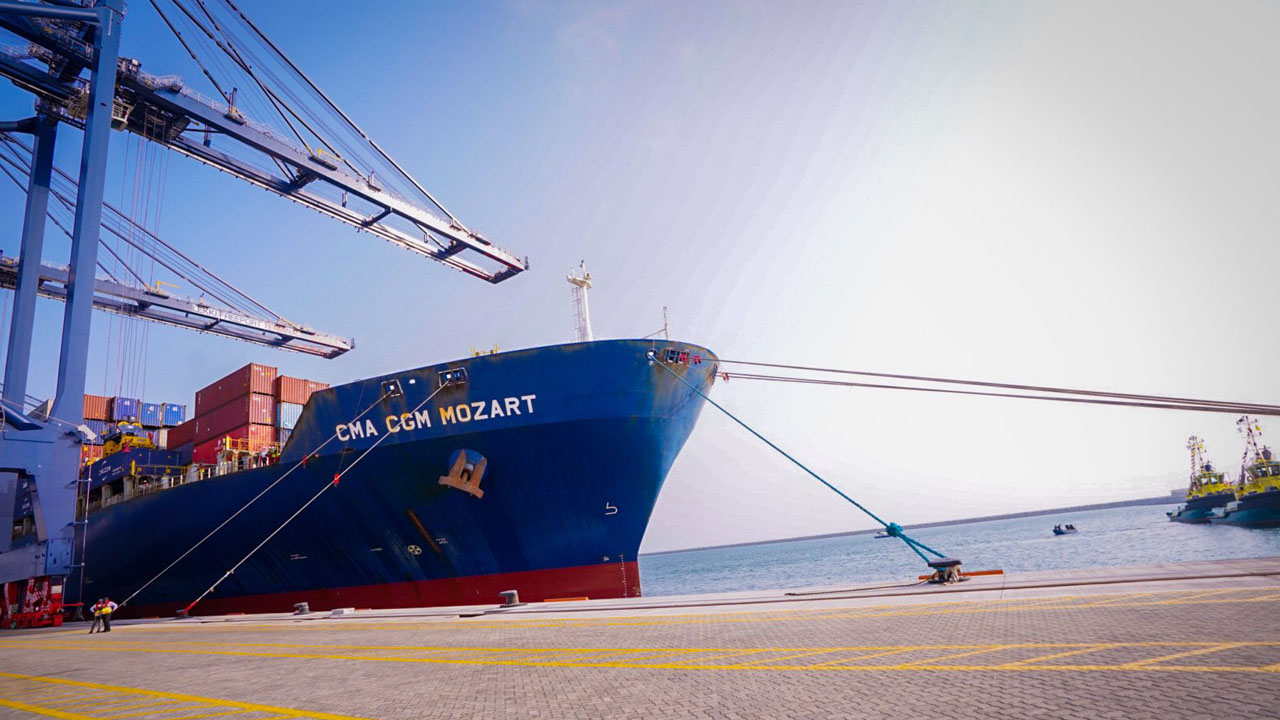
Worried by loss of business to neighbouring countries due to poor port infrastructure, the Lagos and Ogun state governments are making efforts to upgrade infrastructure at the Lekki Deep Seaport to achieve seamless cargo evacuation, ADAKU ONYENUCHEYA writes.
Although the federal government is addressing maritime business losses to the neighbouring countries with the development of the Lekki deep seaport, road infrastructure deficit has remained a major challenge to achieving efficiency in cargo evacuation at the port.
The connecting roads to the port were in dire need of rehabilitation as stakeholders and residents along the corridor feared that not providing the infrastructure needed for efficient cargo evacuation from the seaport would create a replica of Apapa and Tin Can Island ports chaotic gridlock.
The poor state of the roads has threatened the viability of the port and its dream of becoming the maritime logistics hub of the West and Central African region as well as its ability to attain full economic leadership potential under the African Continental Free Trade Agreement (AfCFTA).
There were also fears over the future of the $1.5 billion investment, which is expected to add $361 billion to the economy and generate $201 billion in revenue to the federal and state government agencies through taxes, royalties and duties as well as creating at least 200,000 jobs.
The ports of Lome in Togo, Abidjan in Côte d’Ivoire and Accra in Ghana among other neighbouring countries still attract large volumes of trade in West Africa as Lekki port battles to secure intermodal transport and heavy reliance on barges for its cargo evacuation.
Stakeholders had harped on fixing the road, especially for those whose destinations are not linked by waterways.
The Lagos State Governor, Babajide Sanwo-Olu, during the completion ceremony of the port, reaffirmed the government’s commitment to the timely delivery of the road infrastructure around the Ibeju-Lekki axis to ensure seamless evacuation of cargo from the port.
Road infrastructure upgrade
The deep seaport is connected by three major roads – Ijebu-Ode-Epe-Lekki-Eleko coastal roads, Lekki-Ajah-Eleko coastal roads and Ikorodu-Itokin-Epe roads, which were in dire need of repairs.
Worried by the state of the roads and the need to position the country as the world maritime logistics hub in West Africa and the Central African region, the Lagos and Ogun state governments commenced rehabilitation and upgrade of the road infrastructure to reshape the narrative of cargo evacuation and usher in an era of unparalleled efficiency in timely delivery of cargoes.
The Guardian went on a tour of the roads to ascertain the current state and found that some of the connecting roads have undergone rehabilitation with works still in progress on some.
At the heart of this upgrade is the completed concrete expansion of the Lekki-Epe expressway from Ajah to Eleko junction and that of Oke-Oso/Itokin road to Araga-Poka road as well as the Oke-Oso/Itokin road to Araga-Poka road.
The Guardian correspondent also saw that the upgrading of the Itokin to Ijebu-Ode expressway is completed as well as that of the Ijebu-Ode to Epe road with two toll gates mounted, while the dualisation of the Lekki-Epe road from Ibeju-Agbe to T-Junction in Epe is at 95 per cent completion stage.
It was gathered that the recent enhancements in infrastructure surrounding the port have improved cargo evacuation by road from 20 to 60 per cent and reduced evacuation by waterways via barging to 40 per cent.
An official of the port told The Guardian that at the inception of the port’s operation, it was difficult to move cargoes by road due to the poor state, as evacuation depended solely on barges, which was quite expensive.
The official said with the complete road infrastructure, cargoes leave the port through the Ijebu-Ode to Epe road and the Ikorodu-Itokin road leading to Ijebu-Ode, adding that customers now enjoy seamless delivery of their cargoes at reduced cost.
“I can tell you that the number of cargoes leaving Lekki Port by road has been on the increase in the last few months since these roads were completed. We now do 60 per cent road evacuation of cargoes.
“More roads are still being constructed and we expect the percentage of cargo evacuation to improve as these roads get completed,” the official stated.
Ongoing development
While other road rehabilitation projects have been completed, works are still in progress to ensure the remaining roads linking the port are fixed to set the port for economic competitiveness and position the country as a formidable force in the global trade arena.
The Guardian found that mobilisation towards the complete repair of the Eleko Coastal road, which is directly feeding Lekki deep seaport, has commenced and undergoing phased repairs with concrete pavement and expansion plans already ongoing.
Also, plans are ongoing for the construction of the seventh Axial road, a 50-kilometer route from the port into the hinterland and beyond, which holds the potential to open up new avenues for cargo movement.
The port official said the road construction is being done in phases, which when completed, would finally open Lekki port to global trade.
The port official expressed hope for work to commence on the new seventh Axial road, noting that with this road, cargoes can completely cut off the Eleko junction while navigating into the hinterland of Ijebu-Itele and beyond.

Stakeholders react
The General Secretary, Lagos State Truck and Cargo Operators Committee (LASTCOC), Mohammed Sani, commended the ongoing road rehabilitation by the Lagos state government to ease the movement of cargoes to and from the Lekki Port.
He said this project will prevent the replication of gridlock that has been taking a serious adverse socio-economic toll on Apapa/Tincan Island logistics corridors, arising from a road infrastructure deficit that cannot cope with the volume of trucks that are flooding the ports daily.
Sani said the Lekki deep seaport without an iota of doubt, is a strategic game-changer aimed at addressing the problem of chaotic gridlock and port congestion in Apapa/Tincan logistics corridors, as well as generating revenue for the country.
He said the port is also designed to employ the teeming population, business opportunities for truckers, and become an African hub for transshipment/ handling cargoes in transit for other destinations.
One of the truckers who ply the route, Frederick Omoh, said the trucking community expects an improvement in the percentage of cargo evacuation from the port as the roads get completed by the state governments to avoid a replica of the Apapa axis.
He said with the improved road network, truckers spend less time within the port to pick up their cargoes and leave without any delay or go through rigorous procedures.
Another trucker, Adeyinka Aroyewun, admitted that a lot of movements had started taking place on the axis.
A freight forwarder, Jude Ugochukwu commended the upgrade and rehabilitation of the roads, stating that the port users can conveniently clear their goods and evacuate them seamlessly without fear of having their goods trapped on the road.
He urged the federal government to ensure the issue of rail connectivity to the port is promptly addressed to complement the cargo movement by road and barges.






